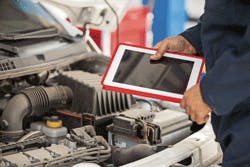With automotive e-retailing taking a hold globally, parts and service divisions of vehicle original equipment manufacturers (OEMs) are beginning to pay attention to the digital channel.
According to recent Frost & Sullivan research, the online market for business-to-consumer parts sales alone is expected to cross the $40 billion mark by 2020. In the U.S., Frost & Sullivan predicts that 15 percent to 20 percent of online parts sales will happen either through direct OEM websites or their dealer digital platforms.
In this scenario, the original equipment service (OES) channel must start laying the groundwork for future success. Here are some key strategic recommendations for creating a robust digital strategy:
• Consider a marketplace e-Store: A direct OEM store, pioneered by BMW, on an online marketplace platform such as eBay is fast becoming a popular strategy in Europe, particularly in the United Kingdom. eBay, for instance, draws a large number of vehicle enthusiasts.
Therefore, automakers with historical presence in sports vehicles can find a dedicated platform to sell to these customer groups. It might also be helpful to support dealer engagement through marketplaces. However, OEMs must also be careful about protecting their brand equity and data while selling to these websites.
• Target service aggregators: Service aggregation, which essentially involves a third-party platform on which service shops can promote their repair facilities and capabilities, is still a nascent area. However, websites such as RepairPal and AutoMD have made strong progress in enabling many independent garages with a centralized tool to attract customers.
While this kind of a website has primarily attracted independent garages, individual dealers may also use service aggregators to promote their services and in turn, draw more service traffic to their shops.
• Create a unified web platform: Many dealers in the U.S. now have dedicated web platforms – and in some cases, mobile apps – for parts and service purchases. However, the approach and strategy vary from dealer to dealer, leading to brand image fragmentation in the market.
To create a more homogenous parts purchase experience that aligns itself with the central brand, OEMs can explore the possibility of a unified web platform or toolkit for their dealers. General Motors has rolled out something similar for new car sales, in which participating dealers are able to create a homogenized web experience through an online toolkit provided by the OEM. A similar model can be applied to online parts and service sales.
• Have a global web store with regional hubs: As global parts e-retailing grows and vehicle platforms become more common across regions with large numbers of shared parts, OEMs should also look into exploring globally standardized e-stores that can be serviced by regional distribution hubs.
Editor’s note: Kumar Saha is an Industry Principal within Frost & Sullivan’s Automotive & Transportation group. For more information on Frost & Sullivan’s Automotive & Transportation research or any questions on this article, call (210) 477-8427 or visit frost.com.
Subscribe to Aftermarket Business World and receive articles like this every month….absolutely free. Click here.


